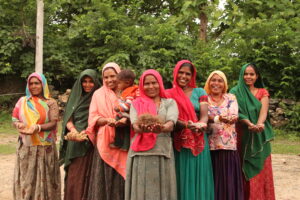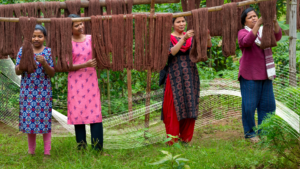Once Swallowed By Lantana Menace, Women Are Reclaiming Forests, Lands And Foods
In Mandla, women are using collective action, traditional knowledge, and sheer determination to restore biodiversity, revive food systems, and rebuild livelihoods
- Aishwarya Mohanty
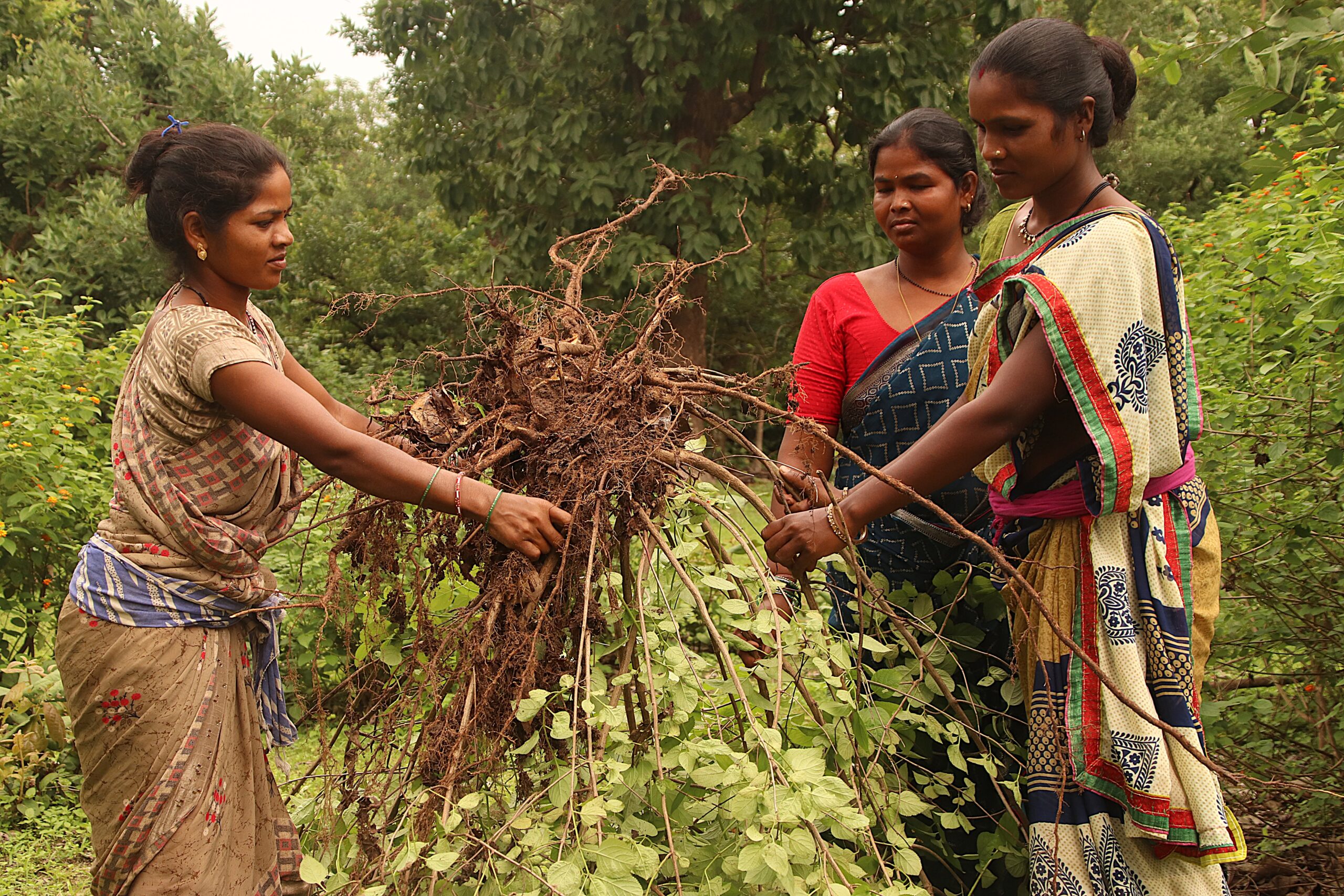
As far as the eye could see, the forest floor in Madhya Pradesh’s Mandla district, once lay smothered under a tangled, thorny blanket of Lantana Camara, one of the world’s most invasive plant species. The unbroken sea of green that hid the earth blocked sunlight and turned fertile lands into thickets that left no space for the grass or trees to grow.
But now, in some parts of Mandla, home to Kanha Tiger Reserve, the scene is slowly changing. Fresh green grass is returning to the ground. Mahua and Palash trees are standing tall again and old forest paths are opening up. This revival is due to some determined community effort.
As the monsoon ends, communities led by women are walking into the Lantana thickets, armed with long, thick branches, sickles, and ropes. They work in groups to lever, pull, and uproot the shrubs. They twist and push the stems, uproot roots from the soil, and turn the plants upside down to prevent regrowth. It is hard work and sharp thorns can cause injuries.
Lantana, locally called Baramaasi (a perennial plant) or Ramphool – might appear harmless; its bright purple and orange blooms are pretty and its leaves aromatic. But for the families living in the fringes of the tiger reserve, it is a menace that has disrupted every aspect of daily life – from farming and foraging to safety and nutrition.
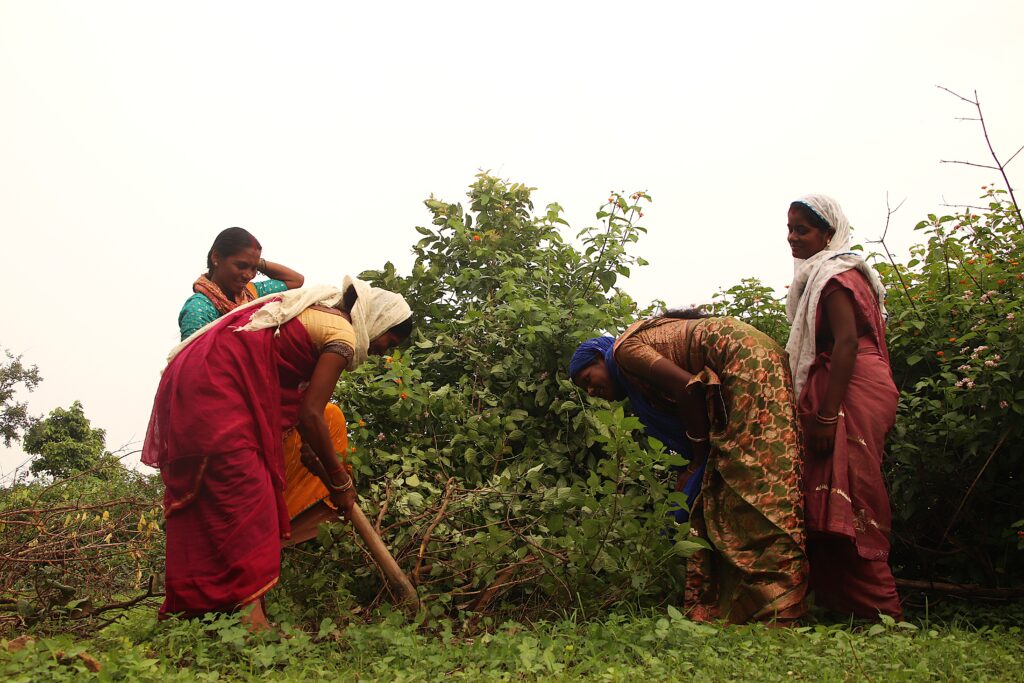
The Green Invasion
“We did not even know what this plant was,” said Heerwati Tekam, from Indravan, in Bicchiya block of the district. “But about 20 years ago, it started appearing more frequently. Within a few years, it had taken over everything, our fields, our mahua trees, the forest paths we used every day.”
An invasive species is identified as a non-native organism that expands its range and causes ecological and economic harm in the new environment. In Indravan, Lantana had once overrun nearly 15 hectares of land. “We did not know that there was land here,”Tekam said.
The Lantana spread meant that the village had no grazing land of its own. “I have two bullocks and two cows. We would walk around 10 km to take them for grazing. Grazing closer to the Kanha forest area also meant a possible risk of attacks by wild animals. We were always scared. Many were also compelled to sell their cattle,” Tekam said.
Indravan is not alone. Across Mandla, the shrub has taken over common and private lands alike, infesting nearly 1,54,000 square kilometers of forest and grassland, more than the size of Greece.
First introduced by the British in the 19th century as an ornamental plant, Lantana adapted with frightening ease to Indian conditions. It now grows aggressively in dry deciduous forests, pushing out native grasses and plant species, and altering entire ecosystems.
For communities in Mandla, the impact was both ecological and deeply personal.
Similarly, in Orai village, Seema Chandrol, 43, had to give away her five cows. Her 4-acre land was overrun by Lantana, leaving no space to graze.
“There were regular conflicts with neighbours if cows wandered into their lands. I was forced to tie them up. But even that made them weak, and I had no other option but to give them up,” Chandrol said. “We cried when we gave them away,” she said. “But what else could we do?”
For these remote villages, domesticated cattle are a vital source of household milk and milk products such as ghee, and paneer.
Forests, which ensured larger food security, cultural linkages, and livelihood opportunities for the Adivasi communities, too were impacted.
“For generations, we have relied on the forests to sustain ourselves. Our lunch and dinner menus were finalised when we foraged. It provides us with everything, we rarely depended on the markets,” said Jagruti Marabi, 50, from Muala Saini village.
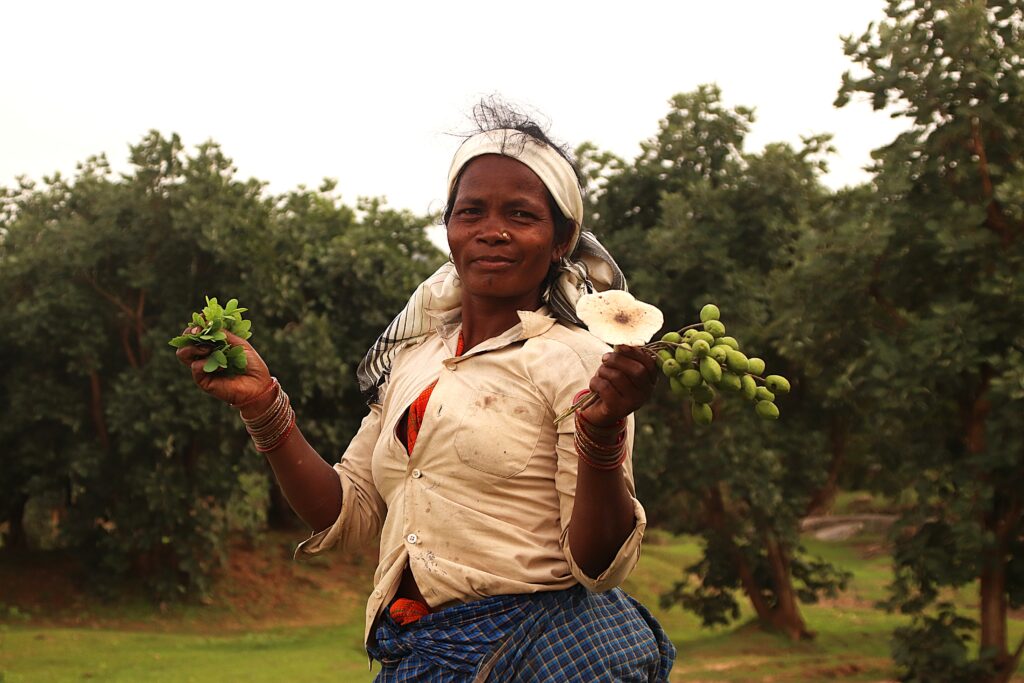
Jagruti counts on her fingertips the various wild edibles that she foraged from the jungles – Mahua, Peehri (wild mushrooms), Chakoda ke beej (Cassia tora seeds), and Karonda (Carissa carandas).
“These edibles were our nutritional mainstays and also culturally important. Mahua, in particular, is also sacred and central to rituals, food, and income,” she added.
Geetha Ramaswamy, a plant ecologist and lead at SeasonWatch, explained how in areas where the forest canopy is open, the Lantana replaces native plants. “This reduces plant diversity, alters nitrogen cycling in the soil, and can even dry up low-lying wet areas. Its dense thickets also affect the movement of wildlife, fragmenting habitats,” she said.
Sunita Yadav, 35, from Barkheda village said that Mahua trees become inaccessible because of the Lantana bushes that grow thick around them. “Our feet would be pierced by thorns. And worse, snakes and wild animals would hide in those bushes. We were terrified of going into the forest,” she said.
With forest produce vanishing, families were forced to depend on markets for vegetables and grains. Their diet changed, eroding their food heritage.
“Our food was simple, nourishing and plentiful because we ate what we grew. You talk about millets today, we have been eating them for generations now. We ate kodo and kutki –easy to grow and super easy to cook,” said Gomiti Marabi, 62, from Muala Saini village.
These lands were traditionally left fallow for a year to regain fertility, but it was also the time the Lantana would overtake the fields.
But the ecological impacts of this invasive species are even graver as Lantana rarely comes alone.
“In parts of the Kanha Tiger Reserve, it co-occurs with Pogostemon benghalensis, another invasive weed. Together, they worsen the soil imbalance — Lantana raising nitrogen and carbon, Pogostemon spiking potassium. Their combined impact disproportionately harms palatable species while allowing some common plants to thrive. Herbivores, forced to overgraze the few remaining edible plants, risks pushing them towards local extinction. It’s a shift that can alter herbivore diets and, over time, entire food webs,” said Rajat Rastogi, a DAAD Doctoral Scholar on Species Interaction Ecology (SIE), who has extensively studied the impacts of invasive species in central India.
The Decision to Uproot
By 2012, many villages in Mandla were awakening to the danger of the shrub’s unchecked growth. Women began to organise and shram daan, or voluntary labour, became the rallying cry. The first attempt was made in Indravan, and the initiative was soon taken up across villages.
“Just think of what was slipping away from us – our forest, our land, our food, our very culture. And for women, it has always been an unspoken duty to guard these lifelines. What shook us most was that this battle was not against a company, or a government office, or even another human being, but a plant. A plant that had quietly taken over our lives, and we stood there, not knowing how to fight it,” Tekam said.
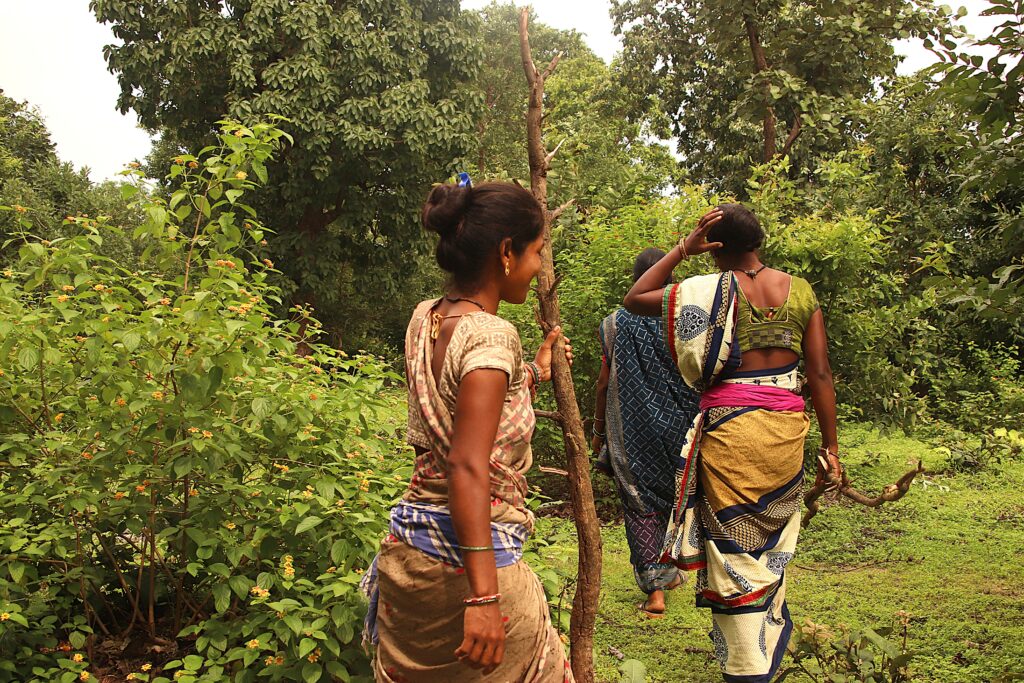
“When we learnt that these plants could be removed, we readily agreed to do it. We knew the only way to reclaim our forests and our common land was through rooting them out. We first took up this discussion in our Mahila Samiti (an all-women grassroots legislative) and then to the Gram Sabha,” she said.
But even today, the area to be cleaned from Lantana is decided and approved – by the forest department (for forest land) and the village panchayat (for village common land) after a resolution is passed.
A single Lantana plant, with thick stems and deep roots, requires at least four people to uproot, the villagers say. They use a large log as a lever, tying it to the base of the plant, pushing and pulling with all their weight until the roots give way. Once uprooted, the plant must be turned upside down to prevent it from re-germinating or pollinating the soil.
For every one acre of land, nearly 50 people are needed daily, the villagers claim. The process is long, laborious, and must be repeated over three consecutive years to ensure the plant doesn’t grow back.
“We would begin right after the monsoon ends. That’s when Lantana spreads the fastest. And we keep going for months. Every hand matters. Every root counts,” said Saraswati Marskoli (32), from Chichari village, where over 14.64 hectares have been reclaimed from Lantana.
Men join too, but the effort is largely women-led, sustained through shram daan and collective resolve. This initiative is currently supported by the Foundation for Ecological Security (FES), in the absence of any concrete government support. Today they earn Rs 243 per day, up from Rs 174 when wages first began. Across Mandla, more than 12,000 women have participated in Lantana removal since 2018, reclaiming 8,849 square kilometers of land.
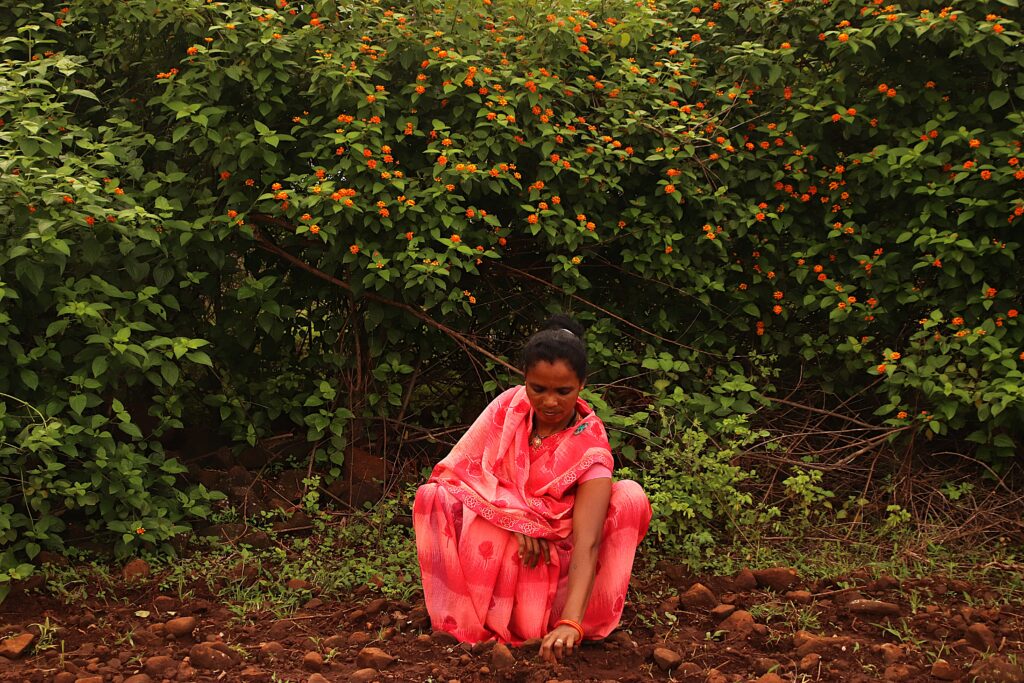
But the work is far from over. “The challenge is that Lantana is extraordinarily resilient. Even if one adult plant is uprooted, its seeds, spread by birds like bulbuls, can lie dormant in the soil for years and sprout again. Cutting or burning only makes it reshoot faster,” said Ramaswamy,
Yet, restoration of the native vegetation is possible. Researchers note that sustained removal over three years allows native grasses, shrubs, and trees to regenerate. Within two years, deer and gaur are observed returning to graze in cleared areas. Still, unless secondary growth is managed and native species actively reintroduced, the cleared land risks being reinvaded,” Rastogi added.
From Forests to Food
In Chichari, villagers weren’t even aware that the overgrown thicket was once common land. It was only when they accessed digital land maps that they realised what had been lost, and what could be brought back. Common lands are essential to community life.
“After we reclaimed the land from Lantana, we collectively decided to build a pond and leave a part of the land for grazing,” said Marskoli.
Today, a 15×15 pond lies on that land, used for cattle, with eight acres now open for rotational grazing, improving the soil and reducing pressure on the forest.
The most visible transformation came not just in land cover, but in the return of forgotten forest produce and traditional food systems. Native trees like Palash, Amla, Harada, and Behada began regenerating. Foraging has resumed, and with it, the taste of tradition. “We eat from the forest again, our meals taste the way they once did,” said Marskoli.
In Manikpur Mal, villagers now grow turmeric, maize, and have adopted seed-ball plantation, throwing seeds of indigenous species into the land to speed up forest revival.
“I have college-going children. But they will get married someday and I will have grandkids. The young ones wouldn’t even know the names of the fruits we ate growing up. Now I will tell my grandchildren, this is your forest. Your grandmother brought this back for you,” said Devki Uikey, 38, from Manikpur Mal.
In Barkheda, a once barren patch of 75 hectares has turned into a lush Palash forest.
“A few years ago, we could not even stand here. The small canal that you see from here was not even visible. We could not even imagine that this place could look like this. Before summers, as Palash flowers come to life, this place looks like magic,” Yadav said.
Here, villagers are not only using these trees for shade and leaf fodder, but also shape plates from leaves, creating a source of livelihood. In several villages, kendu (also called tendu) leaves that were once suppressed under dense Lantana growth have now started flourishing again, providing an additional income stream for households through their sale.
For families, this additional income and revival of their own agricultural land also means reduced migration. As forests began to heal, so did the communities’ relationship with conservation. In Barkheda, villagers set strict forest protection rules.
“Lantana spread because our trees were cut. We’ve learned our lesson,” said Yadav. “Now, anyone caught cutting a tree is fined Rs 50,000 [by the panchayat]. And anyone who reports it gets Rs 5,000.”
Uprooted Lantana is collected, dried, burned, and converted into biochar, a nutrient-rich substance that improves soil health. In some places, Lantana wood is also used for fencing or roofing.
Policy, People, Persistence
Lantana is a globally invasive species, spreading rapidly across tropical and subtropical regions of Asia, Africa, Australia, and America.
Experts stress that India’s invasive species challenge needs more than goodwill. “Intentions are not enough,” Rastogi said. “We need biome-specific strategies, long-term restoration experiments, and policies that cut across biodiversity, agriculture, health, and local economies. Community leadership, especially around protected areas, is key not only to remove Lantana but to ensure ecosystems are restored and livelihoods strengthened.”
There have been sporadic efforts towards managing the invasive species, but without any concrete plan in place.
The community in Mandla, through FES had earlier approached NABARD to include it under invasive species management projects, and later even proposed that it be brought within the ambit of MGNREGA under wasteland management. Yet, nothing materialised.
“Lantana removal is not a one-time exercise, it needs successive interventions over years. Without institutional support, sustaining the effort becomes nearly impossible,” said Pradyumna Acharya of FES. “Community mechanisms are essential to keep the cleared land productive, but they cannot be put in place without a supportive policy ecosystem.” In the absence of such systemic backing, the hard-won gains of communities risk being undone.
As the sun sets over the hills of Mandla, women gather under a mahua tree that was once strangled by Lantana. They laugh, talk, glance at the land and forest that now offers them abundant opportunities, and plan the next day’s work.
“There was a time when we did not know that we could fight it. Today we know. Yes, we would appreciate help in any form. But until that happens, we will continue to fight in whatever capacity we can,” said Uikey. “We are no longer scared of our forests. It is our source of life again.”
[This story is part of a new series “Climate Leaders: Women in Local Climate Action”, a collaboration between Womanity and Behanbox.]
All the stories in the series can be read here.
We believe everyone deserves equal access to accurate news. Support from our readers enables us to keep our journalism open and free for everyone, all over the world.

